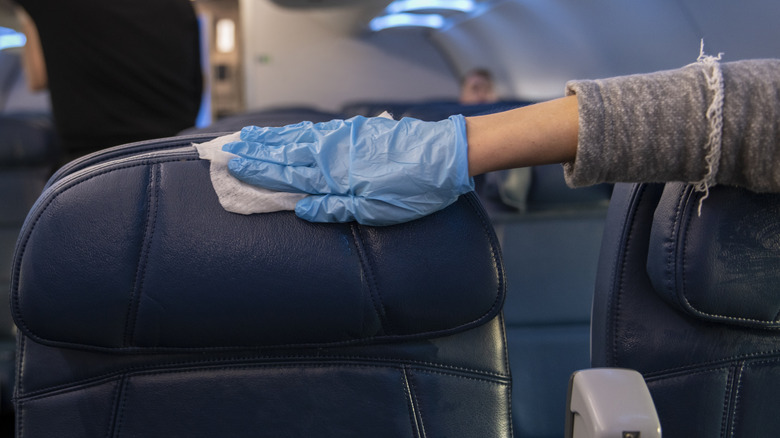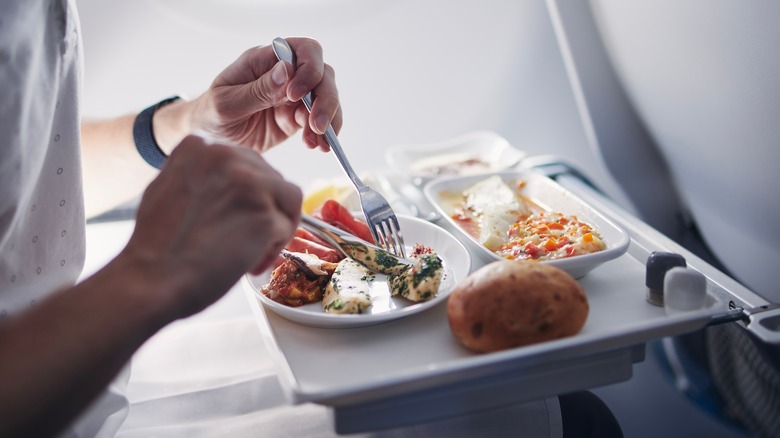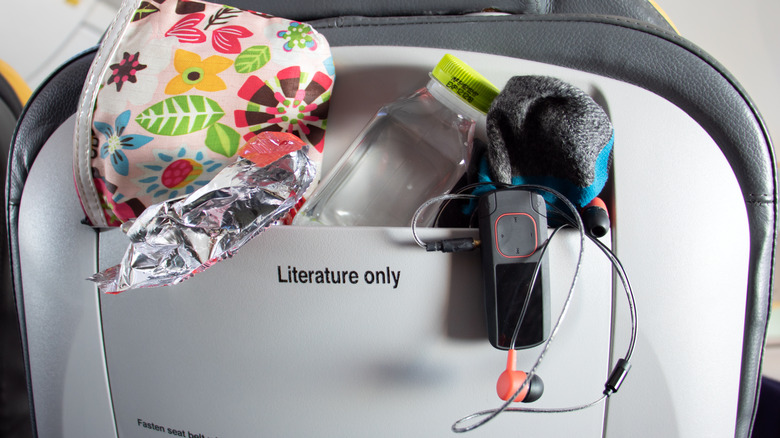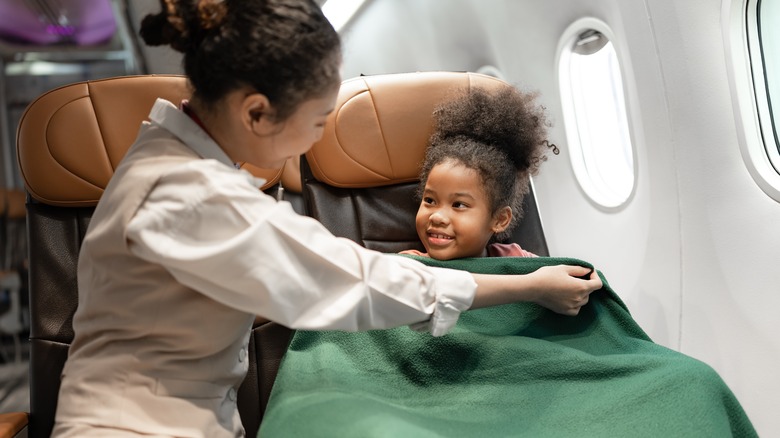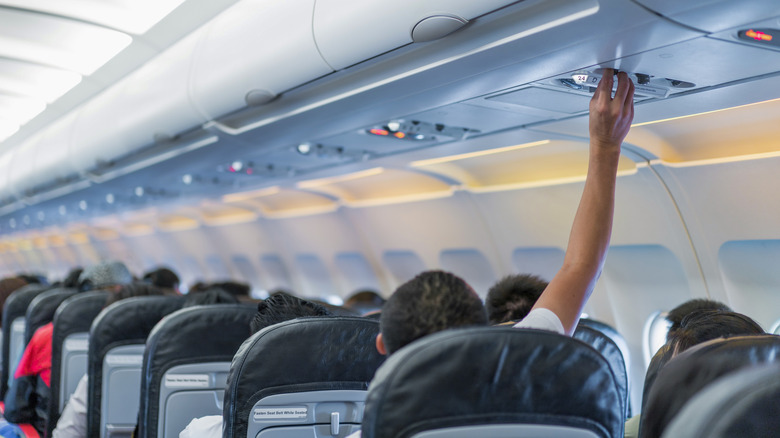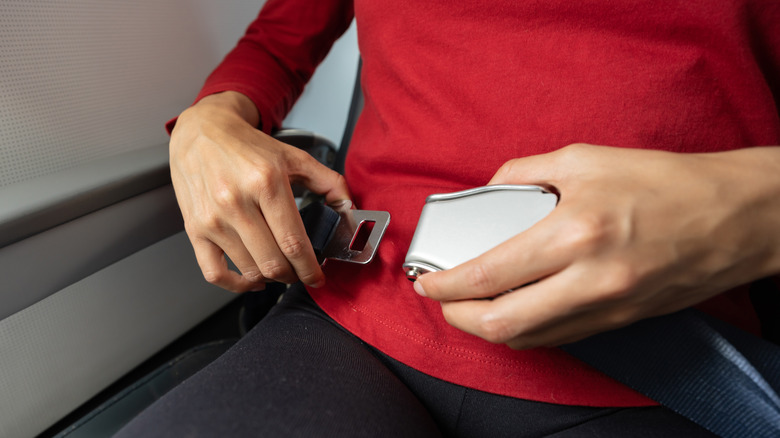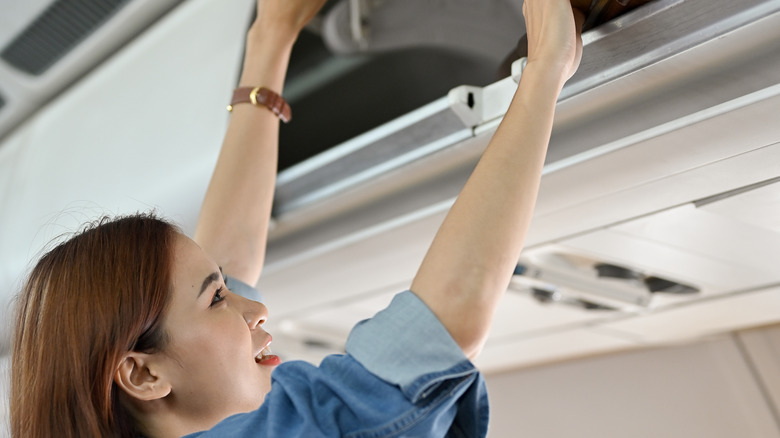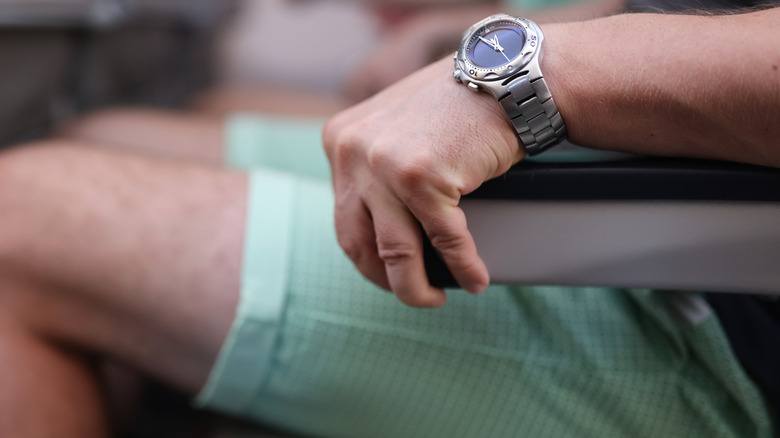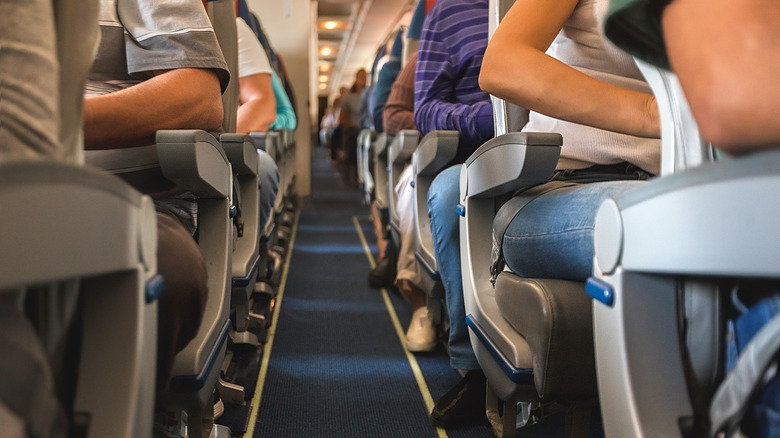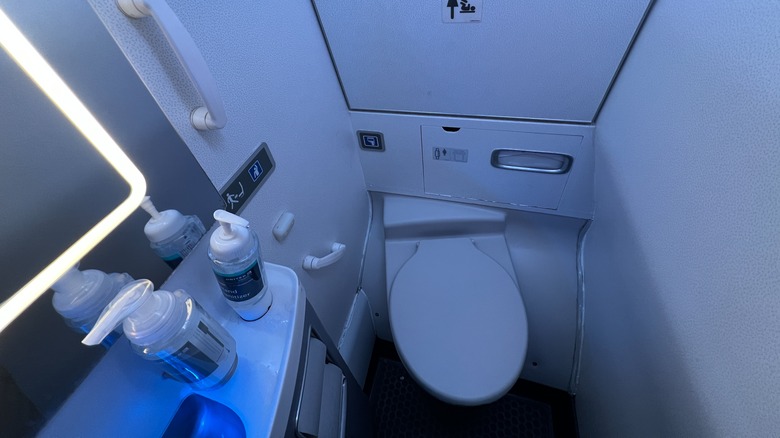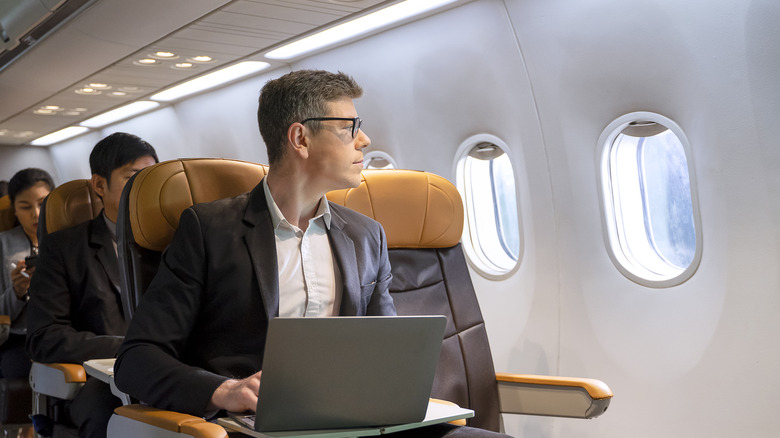Don't Touch These Spots On An Airplane
Once a great novelty, air travel is now an average part of life for many Americans, especially during the busiest travel season in the country – the holidays. That said, flying does a number on your body by inhibiting your immune system because of stress, dehydration, low cabin humidity, and throwing off your circadian rhythm if you fly at odd hours. This is why flying for a lot of folks can pose a range of health issues, in addition to less severe (but still irritating) things like dry skin.
Obviously, though, the main concern for health on airplanes has always been germs. The risk of getting sick while flying predominantly stems from touching so many high-traffic surfaces and being in close proximity with hundreds of other people. Many of these locations aren't sanitized frequently enough, so bacteria (which can survive for hours and even days) can accumulate quickly. The lack of sanitization may not be for lack of trying – there are a lot of surfaces on airplanes that are just difficult, if not impossible, to clean thoroughly. When you add the time and cost to constantly clean every surface all day long, the task becomes unrealistic. When you are catering to so many people every day, germs become unavoidable.
In fact, areas of airports and airplanes can be dirtier than even the nastiest places in your house, such as your toilet seat. And after touching one of these surfaces, you might then touch your face, mouth, phone, or even a complimentary pretzel, transmitting germs into your body. You can't necessarily avoid some of these things altogether, but you can try to make hygienic choices around them.
Tray tables
Travelmath got a microbiologist to swab areas around five airports and four planes to discover where bacteria really congregate – and the top spot might surprise you. They found an average of 2,155 colony-forming units (CFU) per square inch on seat back tray tables, almost 10 times more than the toilet flush button in the lavatories. Who would've thought that the tray tables you eat off of would be one of the grossest parts of the airplane? It's something we touch without even thinking about it.
Other researchers have found cold viruses, noroviruses, and human parainfluenza viruses on airplane tray tables, all of which can cause respiratory infections. They even found the superbug MRSA, which causes skin infections! If you've ever seen someone change a baby's diaper on the tray table (it happens), you'll understand why this part of the airplane is notoriously nasty.
If you wipe down any part of your seating area when you sit on an airplane, ensure it's the tray table. You can also purchase tray table covers to avoid touching the tray at all. These machine-washable covers create a barrier between yourself and the germy tray – just be sure you wash it after use. Another option is to hold your drink and not use the tray at all. This is less useful if you're having a meal, but the point is to avoid the germy tray as much as you can.
Seatback pockets
Over the course of 18 flights, 100 samples were taken for a study conducted by CBC. Of the findings, one of the most worrisome samples revealed that E. coli was present in the seatback pocket samples. E. coli is a particularly dangerous bacteria that wreaks all kinds of havoc on the digestive system and intestines. It makes sense why seatback pockets are so dirty. Like tray tables, this is another area a lot of passengers touch without even thinking. And since some of them are mesh, they're incredibly difficult to clean properly.
While some passengers might use seatback pockets to store magazines, books, and other small items, other people stash their trash, chewed gum, used tissues, filled air sickness bags, and even dirty diapers. Even if you would never dream of leaving such nasty garbage in your pocket, it doesn't mean other passengers haven't done it — even on the flight right before yours.
Suffice it to say, overworked airplane crews and cleaning crews don't have enough time to deep clean a plane between flights. That extends especially to areas of the plane that are hard to clean. Seatback pockets are, unfortunately, one of those areas.
Blankets and pillows
That's right, even the rarely seen complimentary blankies and pillows aren't safe from the germs of airplane life. Sure, a free pillow or blanket is usually welcome when you're trying to catch some z's, but only accept one if it's still sealed in plastic. Blankets and pillows that aren't sealed may be getting reused. While they may get washed in between uses, that's not guaranteed – or even likely. If your blankets and pillows aren't sealed in plastic or another wrapper, take that as a big red flag. When it doubt, just don't use it.
On long-haul flights, you are less likely to encounter this issue, since each seat often comes with a sealed comfort kit. These amenity kits are usually not reused. At worst, airlines might reuse an unopened kit that a previous passenger didn't use. Even so, overall, you should be more wary of touching products handed to you on an airplane.
Even though it takes up extra room, the only way to avoid the questionable sanitization of these products is to bring your own travel pillow or blanket. They'll be better quality than the freebie, anyway! Just make sure to buy a pillow and blanket that can be washed so you don't bring home germs from your flight. You can also invest in something like Safe Travels Kit, which has antimicrobial (and monogrammed) pillowcases.
Air vents
So, the good news is that airplane air vents above your seat are markedly cleaner than the tray tables, according to Travelmath. The bad news is that, all things considered, they're still pretty yucky. That's due in part because, like backseat pockets, the vents themselves are difficult and time-consuming to clean. Crews don't have time to wriggle around the crevices of an air vent while doing their quick spot cleaning in between flights.
While the air itself on airplanes is astonishingly clean (cabin air is heavily filtered, brings in outside air, and changes every three minutes), the air vents are not. Think about it: Folks walk through the airport, touching everything from door handles to water fountains to escalator armrest belts. Then, they get on the plane, touching the seats, the backseat pocket, and the belt buckle, before reaching for the air vent to get comfy. Needless to say, you can assume a lot of dirty hands have touched the air vent before you. That might not be the worst news if you're an early flier – though we can't promise they were cleaned overnight, either.
Travelmath found that, on average, these vents have 285 colony-forming units per square inch, more than on the lavatory flush button. Because of this, it's a good idea to use the sanitizing towelettes some airlines hand out, bring your own, or judiciously use hand sanitizer while on the plane. One trick is to adjust the vent with an antibacterial wipe when you first board the plane and then don't touch it again.
Seatbelt buckles
While many items on this list can be avoided, the one thing every passenger must touch is the seatbelt buckle – and yet, they are seldom cleaned. As expected, this is mostly because doing so would take too much time between flights. The quick cleaning turnaround between flights means trash is picked up, and things are straightened out, but not necessarily cleaned. Most aircraft have over 100 seats, so imagine how long it would take to hit every single belt buckle. You'd end up waiting an hour or longer just for cleaning! And this doesn't even consider cleaning the belt itself, which is likely filled with germs, too.
The average airplane seatbelt buckle has 230 colony-forming units of bacteria per square inch, according to Travelmath, making it the third-germiest surface on the plane. Since so many passengers sit down and buckle without thinking about sanitation, it doesn't necessarily occur to them to clean it first. We get it – it's hard to remember to do anything when you're scrambling to get seated and itching to get going.
Like with the air vent, our best advice is to clean your hands after touching your seatbelt buckle. That includes any time you need to get out of your seat and buckle again. One way to remember to sanitize is to clip a small sanitizer bottle to your personal item; that way, it's accessible throughout the flight. And don't forget to sanitize again after deplaning!
Overhead bin latches
It's always the places we think least about that can impact us the most. According to USA Today, the latches on overhead bins are heavily handled but rarely cleaned. That should come as no surprise because those latches aren't in the seating sections, so they probably don't get as much consideration from cleaning crews. Unless you're only bringing a personal item, you'll probably have to touch the overhead bin at some point. You could wait for someone ahead of you to open it, but if you're a jump-up-upon-landing kind of passenger, then the responsibility of opening the overhead bin will likely fall on you.
Airlines have no regulatory body when it comes to sanitation. Although the FAA has policies on airplane cleanliness, the airlines themselves are free to set their own standards and quality control measures, which they then communicate to contractors to do the job. Basically, cleaners clean to get the job done quickly, not to maximize sanitation. You should also keep in mind that whatever germs you pick up from the latch will inevitably get transferred to your suitcase – a good reminder to never put your suitcase on your bed, at home or your hotel.
Aircraft cabins are generally tidied up between flights, but only get vacuumed, wiped down, and disinfected at the end of the day or after overnight or international flights. But for real deep cleaning, most airlines are only able to do that every 30-45 days on average. Just consider how many passengers go through each plane in that time, and imagine how many of them touch the overhead bins.
Arm rests
Part of the reason so many germs thrive on airplanes is because they are able to survive for long periods of time on the materials. Auburn University researchers found E.coli 0157 bacteria, which can cause severe diarrhea, can live on a rubber armrest for up to four days, longer than on tray tables or in bathrooms. That's nothing compared to the week that MRSA can live inside the cloth seatback pocket.
The cleaning that happens in between flights doesn't involve wiping down armrests, so this would be a good location to clean with a wipe once you get to your seat. Given the tedious nature of wiping down hundreds of armrests, this area is likely overlooked during the quick turnaround between flights.
It's almost impossible to avoid touching an armrest on a plane, especially for seats in the bulkhead area where the tray tables are often attached to the armrest (since there isn't a seat in front of them). So even if you're diligent, if you want to use the tray table at all in that seat, you'll have to touch even more of the armrest than the rest of the passengers on board. This is why you should use hand sanitizer before eating or drinking, and after touching armrests. If you can't avoid the germs, decontaminate them.
Aisle seats
Many people prefer the aisle so they can stretch their legs and not disturb others if they stand up to use the bathroom, but this location also has its pitfalls. Closer proximity to the aisle also means closer proximity to passengers and airline employees moving through the plane, who often use the back of your chair to steady themselves as they walk, including to and from the lavatories.
Think of how many people you see walking through the aisles during a flight. And then remember how many flights that plane made before yours. That's a lot of people! And most of them have probably touched your seat, leaving all their microscopic germs behind to latch onto you. The aisle seat head rest, in particular, gets a lot of action because people use it for stability when walking through the cabin. Especially during periods of turbulence, there is often no choice but to grab onto the nearest object, which is usually the headrest (unless you're tall and can use the overhead bin for stability, but then you have another set of germs to worry about!).
Even the armrest isn't safe from walking passengers. If people brush against it with their pant leg, they could still leave traces of germs behind. Perhaps they dribbled spit or food, or they pat their half-washed hands dry on their pants instead of using a paper towel.
Lavatories
Hundreds of passengers pass through a plane each day, and the average flight has one toilet for every 50 to 75 people. We know that not everyone washes their hands (men more than women skip this step), so we also know that bathrooms are inherently gross. That goes double for lavatories on airplanes, which are more like a toilet closet than a proper bathroom. Plus, how many times have you gone to throw out a paper towel after washing your hands, only to find an over-full garbage can? Now you have to shove your hand down into an unknown sea of used paper towels. Gross!
Restrooms are cleaned regularly but aren't fully disinfected between flights, meaning door locks, faucets, sinks, and handles are all natural places for hundreds of germs to congregate. That is how airplane lavatories ended up being one of the grossest places on an airplane.
And don't get us started on the toilet flush button, which most people touch before washing their hands, giving it the uneasy distinction of having more germs than the toilet itself. According to Travelmath, 265 colon-forming units per square inch are on the lavatory flush button. This is why you should use paper towels when touching the flush button – and any other surface in the lavatory.
But what about the air?
It's common to come down with a cold or something worse after flying. A popular myth is that the air is being recirculated throughout the plane, creating an incubation of germs. But airplane air is actually constantly being cleaned by hospital-grade filters and replaced by clean outside air. On top of that, air in most planes is circulated from top to bottom rather than from front to back, so you're not breathing in the germs of everyone else in front of you.
In fact, airplane air is generally cleaner than that of most office buildings. That's been true for years, but it has been even more true since the COVID-19 pandemic. Ever since then, airlines have stepped up their air filtration game. Even so, one way to protect yourself from breathing in everyone else's germs is to wear a filtering mask. A cloth mask will work too – certainly better than no mask at all. While it isn't the most comfortable way to travel, it is the easiest way to protect yourself from the one thing you can't personally sanitize – the air.
You can also try giving your immune system some super powers, with strategies like taking vitamin C for a few days leading up to a flight and making sure you get plenty of rest ahead of your flight. While this is no guarantee you won't get sick from the plane ride, it can't hurt either. Plus, who doesn't want an immune boost?
